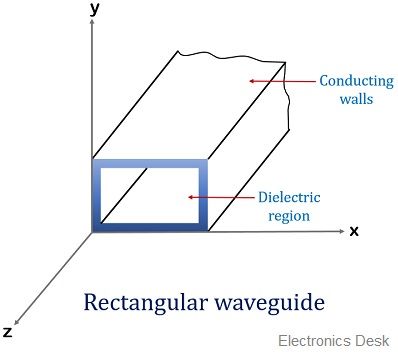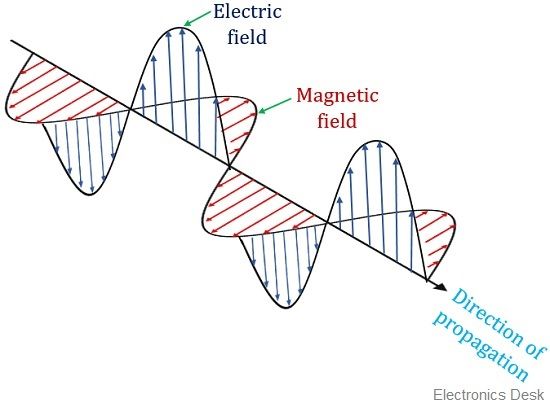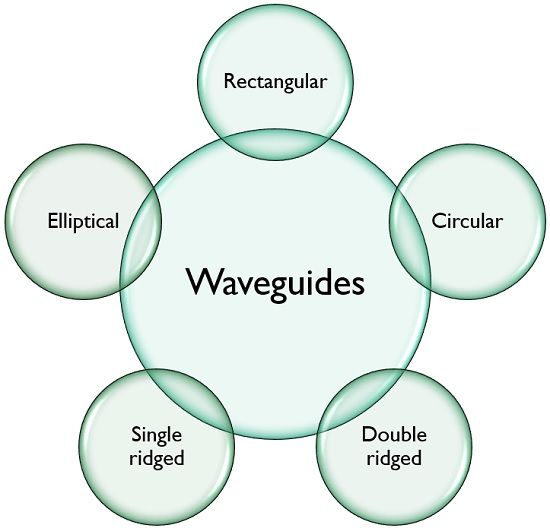Definition: Waveguides are a special category of transmission line that is used to guide (direct) the waves (radiation) along the length of the tube. These are typically a hollow metallic tube that acts as the medium to transfer or transmit power.
Optical fibers are a type of waveguide more specifically we can say dielectric waveguide that operates at optical frequencies in order to transmit the optical (light) signal.
Content: Waveguides
Introduction
In waveguides, the energy is propagated through a tube. It can be either rectangular or cylindrical waveguide that does not consist of any central conductor. These are basically used for the propagation of electromagnetic energy (microwaves) or signal from an end to another. In the case of low-frequency signal transmission, either parallel transmission lines or coaxial cables are used. But in order to have high-frequency signal transmission, waveguides are majorly used.
The frequency of a microwave signal lies somewhere between 300 MHz to 300 GHz. These waves generally propagate in free space with the velocity of light i.e., 3Χ108 m/sec.
Waveguides replaced the transmission lines (or coaxial cables) because of more attenuation and dielectric losses were associated with transmission lines. As with the help of waveguides, small signal attenuation and large bandwidth can be achieved. Waveguides basically function as a high pass filter as it allows the transmission of high-frequency components while attenuating the low-frequency signals.
The figure below represents a rectangular waveguide:
A waveguide transmits a microwave signal by making continuous reflections from the inside walls of the hollow cylindrical tube. The walls of the waveguides are generally made up of copper, aluminum, or brass. However, its inner surface is coated with gold or silver.
Types of waveguides
Waveguides are majorly classified as rectangular or circular but these are basically of 5 different types:
Modes of propagation in a Waveguide
When an electromagnetic wave is transmitted through a waveguide. Then it has two field components that oscillate mutually perpendicular to each other. Out of the two one is electric field and the other is a magnetic field.
The figure below represents the propagation of an electromagnetic wave in the z-direction with the two field components:

The propagation of wave inside the waveguide originates basically 2 modes. However, overall basically 3 modes exist, which are as follows:
- Transverse Electric wave:
In this mode of wave propagation, the electric field component is totally transverse to the direction of wave propagation whereas the magnetic field is not totally transverse to the direction of wave propagation. It is abbreviated as TE mode.

- Transverse Magnetic wave:
In this mode of wave propagation, the magnetic field component is totally transverse to the direction of wave propagation while the electric field is not totally transverse to the direction of wave propagation. It is abbreviated as TM mode.
![]()
- Transverse electromagnetic wave:
In this mode of wave propagation, both the field components i.e., electric and magnetic fields are totally transverse to the direction of wave propagation. It is abbreviated as TEM mode.
![]()
It is to be noted here that, TEM mode is not supported in waveguides. As for the TEM mode, there is a need for the presence of two conductors and we already know that a waveguide is a single hollow conductor.
Now, the question arises why do we need two conductors for the TEM mode to take place?
The answer to the above question is that, in a TEM mode, both electric and magnetic field are totally transverse to the direction of wave propagation.
In the case of two separate conductors this is possible because, from the inner conductor, the electric field generates and terminates at the outer one. And at this particular conductor, a current source must be present in order to generate a magnetic field. But, as we have already discussed that waveguide is a single conductor transmission media. This is the reason why TEM mode is not supported in waveguides.
Parameters of a Waveguide
- Cut-off wavelength: It the maximum signal wavelength of the transmitted signal that can be propagated within the waveguide without any attenuation. This means up to cut-off wavelength, a microwave signal can be easily transmitted through the waveguide. It is denoted by λc.
- Group velocity: Group velocity is the velocity with which wave propagates inside the waveguide. If the transmitted carrier is modulated, then the velocity of the modulation envelope is somewhat less as compared to the carrier signal.
This velocity of the envelope is termed as group velocity. It is represented by Vg. - Phase velocity: It is the velocity with which the transmitted wave changes its phase during propagation. Or we can say it is basically the velocity of a particular phase of the propagating wave. It is denoted by Vp.
- Wave Impedance: It is also known as the characteristic impedance. It is defined as the ratio of the transverse electric field to that of the transverse magnetic field during wave propagation at any point inside the waveguide. It is denoted by Zg.
Advantages of waveguides
- In waveguides, the power loss during propagation is almost negligible.
- Waveguides have the ability to manage large-signal power.
- As waveguides possess a simple structure thus their installation is somewhat easy.
Disadvantages of waveguides
- Its installation and manufacturing cost is high.
- Waveguides are generally rigid in nature and hence sometimes causes difficulty in applications where tube flexibility is required.
- It is somewhat large in size and bulkier as compared to other transmission lines.
It is noteworthy in the case of waveguides that their diameter must have some certain value in order to have proper signal propagation. This is so because if its diameter is very small and the wavelength of the signal to be propagated is large (or signal frequency is small) then it will not be propagated properly.
So, the signal frequency must be greater than the cutoff frequency in order to have a proper signal transmission.

Hello,
Can you say which type of waveguide can only support TEM–cannot support TE or TM?